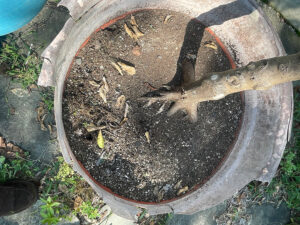In summertime, it’s hot and dry in much of America for extended periods of time, but plants still need water – typically lots of it. What’s more, keeping greenhouse plants watered in these extreme conditions is made even harder when local communities impose lawn and garden watering bans to conserve their rapidly depleting water resources during extended drought. At the same time, prolonged drought means that the barrels of rainwater you previously collected have now been used up. So what are greenhouse gardeners to do in this dire situation? How do they keep their greenhouse plants sufficiently watered? The answer lies in two approaches – water-conserving strategies on the one hand and novel ways of collecting water on the other.

Water-conserving strategies begin at the surface of the soil. Yes, I’m talking about mulch. By reducing water evaporation from the top of soil, mulch keeps the soil moist longer, so plants need less watering. In a greenhouse, mulch can also be used for the soil surface in pots. Shredded straw, clean (not chemically sprayed) grass clippings, and shredded wood bark are ideal mulches for potted plants, even in small pots. Lacking these materials, shredded leaves or shredded paper can also work as greenhouse mulch.
Water-conserving strategies continue above your greenhouse plants. Plants transpire more in bright, hot sunshine, so using a shade cloth on your greenhouse can help reduce the amount of water that plant leaves lose to the surrounding air and therefore the amount of water that needs to be replenished. In my view, putting a shade cloth on a greenhouse exterior does help reduce plant transpiration, but at the risk of having the cloth blow away. If the shade cloth is put inside the greenhouse instead, you know you won’t have to collect it from your neighbor’s yard. But as you install the cloth near the top glazing, be sure to open the upper windows to allow the hot air between the shade and the glass to escape.

Shade cloths can be purchased in many densities, from 10% to 90% shade. How dense a shade cloth to buy greatly depends on your plants’ tolerance of shade. My thinking is that the cloth should provide no more than 50% shade, and even that is too much for some plants. Also be aware of suddenly removing a shade cloth and exposing your plants to bright sunlight that they’ve grown unaccustomed to. The result can be rapid leaf burn. I recently repotted two shade-adapted phalaenopsis orchids and left them in bright greenhouse sun. The sunlight cooked the leaves right off the plants!
Of course, however many water-conserving strategies you use, you’re still going to have to find adequate water for your greenhouse plants when there’s no rain falling coupled with a municipal ban on the lawn and garden use of water from taps. This is where novel water collection strategies come in. With a little creative thinking, there are a number of possible ways to collect water for your greenhouse plants. One is to save the water in which you cook certain foods, such as vegetables, eggs, or pasta. An added advantage of giving this water to your ever-thirsty plants is that the water contains many of the nutrients that the plants require. So the plants are getting not just a much-appreciated drink, but also some of the elements they need for healthy development and growth. Another idea is to collect some of the water that’s used when taking a shower. For instance, instead of letting the initial water drain away while waiting for hot water to arrive, you can save this otherwise wasted water and use it in your greenhouse. You can also take a five-gallon pail into the shower with you and collect the runoff water that’s falling all around you. Use it on plants you are not likely to eat. And these are just a few of the water-gathering possibilities. If you look carefully at your water usage throughout the day, you can probably come up with more ways to collect otherwise wasted water to give to your greenhouse plants.


